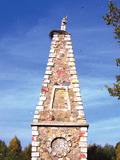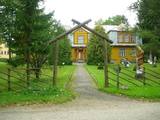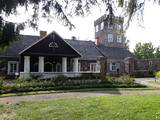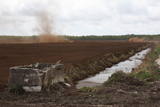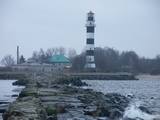| Нo | Название | Описание |
|---|---|---|
|
This park is in a region of hillocks in the Karula highlands, and Lake Ähijärve is at its centre. The park offers a cultural environment of small farms, and it was set up to protect the unique cupola-shaped hillocks of the area. Main attractions: Scenic Lake Ähijärv (176ha), Rebasemõisa Tornimägi hill (137.8 m above sea level), undulating landscapes. |
||
|
Памятник „Несущий Крест” был построен в связи с церковным
юбилейным годом. В 1825 г. Святой год был объявлен в Риме, а спустя год
по всему миру. На высоком и похожем на пирамиду постаменте помещено
изваяние Христа, несущего крест. Памятник в 1828 году построил
ливонский каноник, резекненский декан и писатель Язепс Кирилло.
Восстановлен в 1990 году.
|
||
|
В бывшем парке мызы Мюслери основан своеобразный тематический парк -деревня чудаков-пошехонцев, аттракционы в которой связаны с легендами о пошехонцах, которые были известны в Германии уже 400 лет назад. Пошехонцы - шутники, известные своими непродуктивными, бессмысленными занятиями и шутками. На месте предлагаются юмористические путешествия пошехонцев, в мастерской- изготовление поделок, продажа пошехонских сувениров, питание (для групп- предварительный заказ), место для палаток. |
||
|
В хозяйстве (расположено в верховье берега древней долины Даугавы), растет более 100 видов и сортов растений - декоративные, пряные, лечебные, а также традиционные латышские дворовые растения. Здесь можно увидеть крупнейшие в Латвии насаждения Маньчжурской актинидии (т.е. северное киви). Экскурсия, покупка саженцев растений, дегустация чаев, плодов и ягод и консультации. |
||
|
Dodieties ekskursijā, lai gūtu ieskatu lauku profesijā un dzīvesveidā, kā arī iegūtu jaunus iespaidus un labu atpūtu visai klasei. Ekskursijas laikā apmeklējiet podnieku, kurš skolēniem māca, kā praktiski darboties ar rokām, kā no māla izveidot skaistu darbus ar saviem parakstiem un zīmējumiem. Pēc tam apmeklējiet maiznīcu, kur saimniece piedāvā maizes degustāciju un picu cepšanu. Ekskursijas noslēgumā dodieties uz agro saimniecību, lai redzētu, kā siltumnīcās tiek audzēti tomāti, izmantojot mūsdienīgas fotosintēzes tehnoloģijas. |
||
|
This is a cliff with various levels. Known as the North Estonian cliff, it stretches all along the shore of the Bay of Rīga in Estonia, including some of the local islands. The most expressive part in geological and landscape terms is the Saka-Ontika-Toila cliff, which is around 22 km long and offers an unusual natural environment. The cliff is as much as 53 m high, and it has a fairly virginal forest along its slopes. The layers of clay, sandstone, limestone, etc., come from the Cambrian and Ordovician periods. The Valaste juga (Valaste waterfall) is 24 metres high. After a longer period of freezing temperatures, the waterfall has a particularly impressive appearance. Seasonal waterfalls (8-10 m) can be found near the villages of Ontika and Toila.
|
||
|
С XV века в Приекуле правил род баронов Корфов. Один из них – Иоганн Альберт Корф (1697 - 1766.) был президентом Петербургской Академии наук (1734 - 1740 гг.), дипломатом и литератором, который занимался исследованием истории Курземе. Приекульский замок находится на западе от улицы Айзпуте, на берегу реки Вирга. Первоначально дворец господской усадьбы построили в XVIII веке, а в конце XIX века велись большие работы по перестройке здания (проект Пауля Макса Берчи). В здании находится Приекульская средняя школа. Примерно в 100 м к востоку от господской усадьбы возвышается смотровая башня усадьбы (построена в конце XIX века), над которой развевается государственный флаг Латвии. |
||
|
Калевипоэг- герой Эстонского национального эпоса, и именно Йыгевамаа тесно связано с историями о нем. Здесь меч Калевипоэга в реке Кяапа, места отдыха, камни, родники, болота, вспаханные борозды, следы лошади и т. д. В музее Калевипоэга 12 тематических комнат, где представлены связанные с ним материалы и Эстонское культурное наследие. Перед зданием музея- заповедный сад и 17 деревянных скульптур героев эпоса. |
||
|
Находится напротив Бренгульской пивоварни, где варят пиво (нефильтрованное, непастерилизованное) из зерна, выращенного местными крестьянами, используя знания предков. В открытом кафе можно купить темное и светлое Бренгульское пиво, а также отведать латышские блюда. Латышская кухня: Серый горох с салом, колбаски с капустой, руенское мороженое. |
||
|
Der dritgrößte Feldstein im Baltikum (584 m3, 7 m hoch, Durchmesser bei dem Grund – 32 m ). Auf estnisch bedeutet „Hausstein”. Befindet sich am Rande des Pikanõmme – Majakivi Pfades (4,5 km lang). |
||
|
Near the Priedīši homestead, there is a nature trail which allows visitors to study Lake Dziļezers and the surroundings. There are various lakes in this region which are found in a depression left behind by the Ice Age – Lake Dziļezers, Lake Riebezers, Lake Mazezers, Lake Auziņš, Lake Skuja and Lake Bruņķītis are all there. Along their shores, there are various kinds of forests, including ones with broadleaf trees that are under environmental protection. The trail is 3km in length and will take an hour or so to traverse. This is a part of the environmentally restricted territory of Lake Dziļezers and Lake Riebezers.
|
||
|
Производят кондитерские изделия из натуральных продуктов. Предлагают салаты, пиццы, пирожные, мороженое и другие лакомства. |
||
|
Atrodas Rīgas – Ventspils autoceļa (A 10) 92. kilometrā. Piedāvā ēdināšanas pakalpojumus, klāj galdus un organizē citus pasākumus. |
||
|
Культурно-исторический музей-заповедник реки Даугивене, основанный в усадьбе Бурбишкис в 1991 г., занимает 28 га. В центральной части парка (3 га) расположен пруд с 15 островками, 11 мостами и мостиками. С 2000 г. здесь проводятся праздники цветения тюльпанов, во время которых демонстрируется около 300 сортов тюльпанов. |
||
|
There are three large lakes at the centre of this park – Lake Dusia, Lake Metelys, and Lake Obelija. Lake Dusia has very clear and transparent water, and its southern and south-eastern beaches are popular among swimmers. The lakes and their nearby wetlands are important during the migration season of birds.
|
||
|
Atrodas Ēdoles centrā. Dievnams tapis 17. gs. vidū, pateicoties Ēdoles pils īpašnieka - Johana Dītriha Bēra iniciatīvai, kas to veltījis sava noslepkavotā tēva piemiņai, domādams, ka tādējādi varēs izpirkt brāļa Filipa - tēva slepkavas grēkus. Lai izpirktu savējos, J. D. Bērs licis sevi paglabāt zem baznīcas durvju sliekšņa. Dievnama iekštelpas rotā sākotnējais baroka interjers, kā arī krāšņs ērģeļu prospekts un luktu apdares elementi. |
||
|
Популярное кафе в центре Сигулды – напротив железнодорожного вокзала. Предлагают завтраки, салаты, закуски, основные блюда. Натуральные, вкусные кондитерские и кулинарные изделия. |
||
|
Nature restricted area is established to protect various wetland habitats – Big Kirba Bog and protected plant species within it. Only the West part of the Bog is a protected nature area. The rest of the bog is used mainly for intensive extraction of peat and large cranberry cultivation. Nature restricted area of the bog has no tourism infrastructure therefore is not useable for tourist visits.
|
||
|
1996. g. atklātais piemineklis (tēlniece: A. Veinbaha) Dagdā (starp Asūnes un Rēzeknes ielām) ir piemiņas vieta komunisma terora upuriem. No šejienes paveras labs skats uz salām bagāto Dagdas ezeru. |
||
|
Западный мол (построен в 1885-м году) простирается в море на 860 метров и вместе с Восточным молом регулирует впадение Даугавы в море, уменьшая ее засорение. В основании гидротехнического сооружения находится сваевая конструкция, укрепленная камнями. Мол многократно реконструировался и укреплялся. В 19-м веке на моле находилась каторжная тюрьма. Примерно половина мола восстановлена путем бетонирования. Остальная часть в данный момент находится в довольно плачевном состоянии! Уже в 1528-м году польский король Стефан Баторий издал приказ о строительстве маяка в устье Даугавы. Первая карта, на которой изображен маяк, датируется 1536-м годом. В учете маяков Российской империи за 1721-й год указано, что здесь находится нагромождение камней, на котором зажигается огонь. Позже были построены деревянные и каменные башни, которые во время войн были уничтожены. Современный Даугавгривский маяк высотой 35 метров был построен в 1957-м году. Огни маяка видны на расстоянии 18 морских миль. |
||

